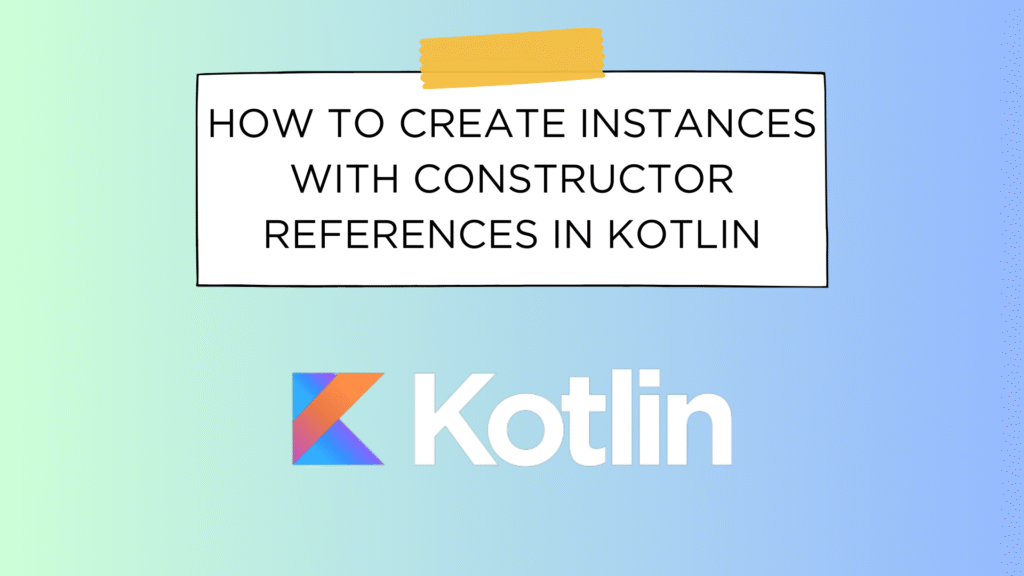In software development, design patterns offer proven solutions to common problems. They provide a standardized approach to designing and implementing software, making code more readable, maintainable, and scalable. Kotlin, a modern, statically typed programming language running on the JVM, is well-suited for implementing design patterns. Here, I will guide you through some of the most commonly used design patterns in Kotlin.
The True Power of Design Patterns
Design patterns are tried-and-tested solutions to common problems in software design. Think of them as templates that help developers solve recurring challenges in a structured way. By using design patterns, developers can write code that is more efficient, easier to maintain, and easier to understand. These patterns also create a common language among developers, making it simpler to communicate and collaborate. While design patterns can be very useful, it’s important to use them thoughtfully and only when they fit the specific problem you’re trying to solve.
Origins: From Architecture to Software
The concept of design patterns originally came from architecture, not software. In the late 1970s, architect Christopher Alexander introduced design patterns in his book “A Pattern Language.” He and his team identified common problems in building design and suggested solutions that could be reused in different situations. These solutions were documented as patterns, providing a shared language that architects could use to create better buildings.
This idea caught the attention of the software community, which faced similar issues when designing complex systems. By the 1980s and early 1990s, software developers started adapting these architectural patterns to help solve problems in software design.
The Gang of Four: A Key Moment
A major milestone in software design patterns came in 1994 with the publication of the book “Design Patterns: Elements of Reusable Object-Oriented Software.” This book was written by four authors — Erich Gamma, Richard Helm, Ralph Johnson, and John Vlissides — who are often referred to as the “Gang of Four” (GoF).
The Gang of Four identified 23 design patterns that address specific problems in object-oriented programming. They grouped these patterns into three categories:
- Creational Patterns: Focus on how objects are created, helping ensure systems can grow easily. Examples: Singleton, Factory, and Builder patterns.
- Structural Patterns: Deal with how classes and objects are organized, making complex systems easier to manage. Examples: Adapter, Composite, and Decorator patterns.
- Behavioral Patterns: Focus on how objects communicate and work together. Examples: Observer, Strategy, and Command patterns.
Their work provided us (developers) with a common set of best practices that could be consistently applied to software design, making their book a foundational resource for learning about design patterns.
Evolution and Modern Perspectives
Since the publication of the GoF book, design patterns have continued to evolve, adapting to new programming paradigms, technologies, and methodologies. As software development shifted towards more dynamic languages and frameworks, we developers began to explore and document new patterns that addressed emerging challenges.
In the context of Android development, architectural patterns like Model-View-ViewModel (MVVM) and Model-View-Presenter (MVP) have gained prominence. These patterns have been developed to tackle the complexities of building scalable, maintainable, and testable mobile applications.
MVVM (Model-View-ViewModel): MVVM separates the application logic from the UI, facilitating a cleaner and more modular architecture. In MVVM, the ViewModel handles the logic and state of the UI, the View is responsible for rendering the UI and user interactions, and the Model manages the data and business logic. This pattern integrates well with Android’s data-binding library, LiveData, and Flow, promoting a reactive and decoupled approach to app development.
MVP (Model-View-Presenter): MVP also promotes the separation of concerns but differs in how it manages interactions between components. In MVP, the Presenter acts as an intermediary between the View and the Model. It handles user inputs, updates the Model, and updates the View accordingly. This pattern can be particularly useful for applications requiring complex user interactions and more straightforward unit testing.
Other Modern Architectures: The rise of microservices and modularization has influenced Android architecture as well, encouraging practices that support more granular and scalable app development. Patterns like Clean Architecture and the use of Dependency Injection frameworks (e.g., Dagger, Hilt) have become integral to developing robust and maintainable Android applications.
In addition to new patterns, the community has also refined existing ones, adapting them to modern contexts. For example, the Singleton pattern has been revisited with a focus on thread safety and lazy initialization in multi-threaded environments.
Common Design Patterns
The main categories of design patterns are:
- Creational Patterns: Deal with object creation mechanisms.
- Structural Patterns: Concerned with object composition or structure.
- Behavioral Patterns: Focus on communication between objects.
In Kotlin, thanks to its concise syntax and powerful features like higher-order functions, extension functions, and null safety, implementing design patterns often becomes more streamlined compared to other languages like Java.
Creational Patterns
These patterns deal with object creation mechanisms, trying to create objects in a manner suitable for the situation.
- Singleton: Ensures a class has only one instance and provides a global point of access to it.
- Factory Method: Defines an interface for creating an object, but lets subclasses alter the type of objects that will be created.
- Abstract Factory: Provides an interface for creating families of related or dependent objects without specifying their concrete classes.
- Builder: Separates the construction of a complex object from its representation.
- Prototype: Creates new objects by copying an existing object, known as the prototype.
Structural Patterns
These patterns focus on composing classes or objects into larger structures, like classes or object composition.
- Adapter: Allows incompatible interfaces to work together by wrapping an existing class with a new interface.
- Bridge: Separates an object’s abstraction from its implementation so that the two can vary independently.
- Composite: Composes objects into tree structures to represent part-whole hierarchies.
- Decorator: Adds responsibilities to objects dynamically.
- Facade: Provides a simplified interface to a complex subsystem.
- Flyweight: Reduces the cost of creating and manipulating a large number of similar objects.
- Proxy: Provides a surrogate or placeholder for another object to control access to it.
Behavioral Patterns
These patterns are concerned with algorithms and the assignment of responsibilities between objects.
- Chain of Responsibility: Passes a request along a chain of handlers, where each handler can process the request or pass it on.
- Command: Encapsulates a request as an object, thereby allowing for parameterization and queuing of requests.
- Interpreter: Defines a representation of a grammar for a language and an interpreter to interpret sentences in the language.
- Iterator: Provides a way to access elements of a collection sequentially without exposing its underlying representation.
- Mediator: Reduces chaotic dependencies between objects by having them communicate through a mediator object.
- Memento: Captures and externalizes an object’s internal state without violating encapsulation, so it can be restored later.
- Observer: Defines a one-to-many dependency between objects so that when one object changes state, all its dependents are notified.
- State: Allows an object to alter its behavior when its internal state changes.
- Strategy: Defines a family of algorithms, encapsulates each one and makes them interchangeable.
- Template Method: Defines the skeleton of an algorithm in a method, deferring some steps to subclasses.
- Visitor: Represents an operation to be performed on elements of an object structure, allowing new operations to be defined without changing the classes of the elements on which it operates.
Why Do We Use Design Patterns?
Several compelling reasons drive the utilization of design patterns, especially in the context of Android development:
Reusability: Design patterns provide proven solutions to recurring problems in Android development, whether it’s managing UI interactions, handling data flow, or structuring complex applications. By leveraging these patterns, developers can avoid reinventing the wheel, thereby promoting reusability and modularity in Android apps.
Improved Communication: In Android development, where teams often collaborate on different parts of an app, design patterns establish a shared vocabulary and understanding among developers. This shared language facilitates more effective communication about design decisions, making it easier to align on architecture and implementation strategies.
Best Practices: Design patterns encapsulate the best practices of experienced Android developers. Whether it’s using MVVM for a clean separation of concerns or implementing Dependency Injection for better scalability, these patterns serve as a learning ground for novices to adopt industry-proven approaches, ensuring that the code adheres to high standards.
Maintainability: The use of design patterns often leads to more maintainable Android code. For example, adopting the Repository pattern can simplify data management across different sources, making the code easier to update, debug, and extend as the app evolves. This maintainability is crucial for Android apps, which often need to support various devices, screen sizes, and OS versions.
Easier Problem-Solving: Design patterns offer a structured approach to problem-solving in Android development. They aid developers in breaking down complex issues — like handling asynchronous operations or managing state across activities — into more manageable components. This structured approach not only speeds up development but also leads to more robust and error-free applications.
Choosing the Right Design Pattern
It’s super important to use design patterns wisely, especially in Android development. Think of them as powerful tools, but not every tool is suited for every task, Right? Here’s why:
Think About the Situation: Design patterns are most effective in specific contexts within Android development. For example, while MVVM is excellent for handling UI logic, it might be overkill for a simple utility app. Using a pattern just for the sake of it can lead to unnecessary complexity.
Keep It Simple: Android development can get complex quickly, especially when dealing with things like lifecycle management and background tasks. Sometimes, a straightforward solution — like using basic Android components instead of a full-blown architecture pattern — is better. Don’t complicate your app with patterns that aren’t needed.
Watch Out for Speed Bumps: Implementing certain design patterns can introduce overhead that might affect performance, particularly in resource-constrained environments like mobile devices. For instance, dependency injection frameworks like Dagger can slow down app startup time if not used carefully. Always weigh the benefits against the potential performance impacts.
Be Ready to Change: As your Android project evolves, the design patterns you initially chose might no longer be the best fit. For example, an app that started with a simple MVP architecture might need to transition to MVVM as it grows in complexity. Flexibility and the willingness to refactor are key to maintaining a healthy codebase.
Using design patterns in Android development is like having a toolbox full of helpful tools. Just remember, not every tool is right for every job. We should pick the ones that fit the situation best. If we do that, our Android apps will be robust, efficient, and easier to maintain!
Conclusion
Design patterns are powerful tools in the software developer’s arsenal. They provide a structured and proven approach to solving recurring problems, fostering reusability, modularity, and better communication within teams. However, like any tool, they must be used wisely, with an understanding of the specific context and potential trade-offs. By mastering design patterns, developers can craft robust, maintainable, and scalable software solutions, leveraging the collective wisdom of the software engineering community.












